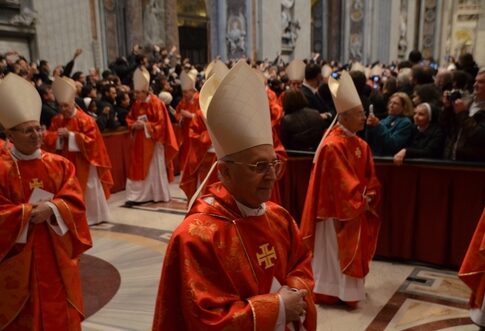A shocking act of desecration at Catholicism’s holiest site raises urgent questions about the erosion of sacred values and the safety of cherished institutions under modern threats.
Desecration at the Heart of Catholicism
On October 10, 2025, during the 9 a.m. Holy Mass at St. Peter’s Basilica in Vatican City, a man climbed onto the Altar of Confession and urinated in front of hundreds of stunned worshippers and tourists. The Altar of Confession holds deep significance as the most sacred site in Catholicism, situated above the tomb of St. Peter and reserved for the most solemn papal liturgies. Security officers responded immediately, removing the perpetrator, but the incident’s gravity has sent shockwaves far beyond Rome. This brazen act was captured on video, rapidly spreading across social media and magnifying public outrage over the violation of one of the faith’s holiest places.
VATICAN CITY—CONFIRMED that a man desecrated the Papal Altar of St Peter’s Basilica, at 9:30AM yesterday morning, by urinating on it in the presence of hundreds of pilgrims.
Holy Mass was being celebrated, at the time, at the Altar of the Chair.
— Bree A Dail (@breeadail) October 11, 2025
The Vatican’s silence in the wake of this desecration has only heightened global concern. As of October 12, 2025, no official statement had been issued regarding the identity, motives, or legal consequences for the perpetrator. This lack of transparency stands in stark contrast to the open distress of the Catholic faithful, clergy, and the wider public, who view the basilica not just as a monument but as a living symbol of religious tradition and Western heritage. Reports circulate that Pope Leo XIV was “shocked,” though official confirmation remains absent. The unresolved status fuels speculation about whether this was an isolated act of mental instability, a protest, or symptomatic of deeper societal unrest.
Pattern of Attacks and Lax Security
This incident is not an isolated case but part of a troubling pattern of vandalism and disrespect toward sacred sites in recent years. Prior episodes at St. Peter’s Basilica include a February 2025 event where a man threw candelabras from the altar and a 2023 protest where an individual undressed and displayed a political message atop the altar. Each act chips away at the sanctity of the basilica and signals a growing trend: the weakening of societal respect for religious and cultural values. Despite typically tight security, the open nature of public liturgies gives would-be offenders access—exposing the tension between openness and the need for robust protection against those intent on causing harm or making political statements.
Heightened tourist traffic in the post-pandemic era has added to security pressures, yet the response to these incidents is perceived as inadequate by many observers. Calls for increased screening and surveillance are mounting, especially as video evidence of the latest desecration circulates globally. Critics argue that the lack of a decisive and transparent response undermines confidence in the Vatican’s ability to defend its sacred spaces and, by extension, the values they represent.
Broader Implications: Erosion of Values and Social Order
The desecration of the Altar of Confession resonates far beyond the Catholic community, symbolizing a broader erosion of respect for tradition and sacred institutions. For many conservatives, such incidents are viewed as the result of societal decay fueled by the abandonment of traditional values, lack of accountability, and a culture that too often excuses disruptive or even criminal behavior. The fact that acts like these are increasingly frequent—and that perpetrators often escape meaningful consequences—stirs fears about the future of Western heritage and the stability of foundational social norms.
Expert commentary suggests that these events reflect larger societal tensions, from mental health crises to ideological protest. Church historians emphasize the unparalleled gravity of desecrating the basilica’s altar, while sociologists debate whether such acts are symptoms of alienation or deliberate assaults on tradition. Regardless of motive, the impact is immediate: heightened anxiety among worshippers, pressure on security forces, and renewed debate about how to safeguard institutions vital to both religious and national identity. Limited data on the perpetrator’s background and intent leaves essential questions unanswered, but the pattern is clear—without strong, principled defense of tradition, even the most sacred sites are at risk.
Who Is Responsible and What Comes Next?
Responsibility for protecting sacred spaces like St. Peter’s Basilica ultimately falls to authorities who must balance openness to the public with robust defense against those who would desecrate or disrupt. The Vatican’s current approach—marked by silence and reactive measures—has left many feeling vulnerable and disillusioned. Faithful Catholics, traditionalists, and defenders of Western values expect more than apologies after the fact; they demand proactive security, swift justice, and cultural leadership that upholds the sanctity of cherished institutions. Until these expectations are met, every new attack will serve as a grim reminder of what is at stake when society fails to defend its core values.
VATICAN
Anti Catholic terrorist tries to steal baby Jesus from crib in St. Peter's Square on the Feast of the Holy Innocentspic.twitter.com/9TrXDjzAAp
— TruthUnfiltered (@Truth_Unfiltere) October 11, 2025
As the story develops and investigations continue, the faithful and concerned citizens alike will watch closely for meaningful action—not just words—aimed at restoring security and respect to the heart of Catholic tradition. The outcome will be a test not only for Vatican leadership but for all who cherish the foundational principles of faith, order, and cultural continuity in a rapidly changing world.
Sources:
Catholic World Report: Man desecrates altar of St. Peter’s Basilica
Brut Media: Man pees on St. Peter’s Basilica Altar of Confession
EWTN Vatican: St. Peter’s Basilica Altar Desecration 2025

